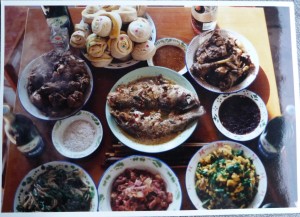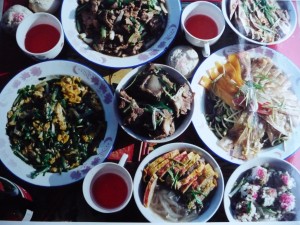Happy New Year!
 Last year I gave you a few photographs of Chinese New Year in Hunan, 2004. This year, here are a couple of photographs of Chinese New Year meals in the far north of the country, in a remote part of Gansu Province in 1995. They were taken in the village that is the subject of the chapter ‘Hungry Ghosts’ in my book Shark’s Fin and Sichuan Pepper. (Please forgive the poor quality of the images! I may try to scan them properly another time!)
Last year I gave you a few photographs of Chinese New Year in Hunan, 2004. This year, here are a couple of photographs of Chinese New Year meals in the far north of the country, in a remote part of Gansu Province in 1995. They were taken in the village that is the subject of the chapter ‘Hungry Ghosts’ in my book Shark’s Fin and Sichuan Pepper. (Please forgive the poor quality of the images! I may try to scan them properly another time!)
On the right, you can see a pair of fish (fish are an almost obligatory part of New Year’s Eve dinners because nian nian you yu is a phrase that can mean both ‘fish every year’ and ‘plenty every year’: so the dish is an auspicious play on words.) You can also see home-reared chicken, and chunks of meat from the pig the household had fattened up in the last months of the lunar year, as well as steamed buns (hua juan) dotted with food colourings to make them look more festive. In the cold, arid north, particularly  in rural areas like this, wheaten foods such as hua juan, man tou 馒头 (plain steamed buns), deep-fried dough-twists (麻花 ma hua), noodles and dumplings are normally eaten rather than rice.
in rural areas like this, wheaten foods such as hua juan, man tou 馒头 (plain steamed buns), deep-fried dough-twists (麻花 ma hua), noodles and dumplings are normally eaten rather than rice.
On the left, you can see several of the ingenious ways in which local people transformed one kind of food (pork) into many different tastes and textures. In the centre there are chunks of meat, on the bone; on the top left a stir-fry of lean meat and green onions or chives; centre bottom a kind of meatball wrapped in eggskin, steamed and then sliced; bottom right some ‘pearly meatballs’ made from minced pork studded with whole rice grains; and on centre right slices of a jelly made from the skin, which I was given in every single household, and which was usually made in a few different colours, using food colourings. And on the top left, you can see a few steamed buns, which were eaten with the main dishes.
Anyway, I must stop writing and start cooking, because I have some people coming over for a New Year’s dinner and it’s getting late! On the menu: spinach with either a gingery or sour-hot dressing (haven’t decided yet), spicy cucumber salad, a stew of red-braised wild venison with beancurd sticks, Gong Bao chicken, stir-fried pork and yellow chives, steamed wild sea bass with ginger and spring onion, Chinese broccoli with ginger, fish-fragrant aubergines (I find it hard to do a dinner party without them, and they are often the most popular dish), and a couple of other dishes TBC. Oh, and some of the winter meats mentioned in my previous post, steamed, sliced and served with ground chillies and Sichuan pepper in homage to my beloved Chengdu. The stew is simmering away as I finish this post, wafting out lovely aromas of fermented chillies and beans, ginger, spring onion, venison and star anise.
Happy New Year!

12 Responses to “Happy New Year!”
Hi Fuchsia, Happy Year of the Dragon! I know nothing about the food of Gansu; this is fascinating. Your Lunar New Year dinner sounds lovely (and effortful). I spent some time working in Chengdu years ago and am impressed by your work.
Best wishes for a prosperous Year!
Linda (@spiceboxtravels)
Wow your Chinese New Year feast sounds too good to be true. I do keep meaning to make your fish fragrant aubergines. I decided to celebrate the Chinese new Year in our household today by making a wonderful Char siu belly of pork with rice and pak choi stir fried with garlic. All the family devoured it and there is some left over although I am still totally stuffed!
Happy Year of the Dragon to you!
This sounds delicious. I was delighted to find your recipe for fish fragrant aubergine in Sichuan cookery. I had had it in Hongkong and Vancouver and had never got it in a restaurant in Ireland. I have made it(in several variations stuffed with mushroom, with pork, battered not battered) to universal delight.
Your planned feast like you speak of here. I admire your industry
Margaret
Happy New Year! Your dinner sounds amazing.
Happy New Year, Fuschia! That menu sounds delicious. How do you manage to make so many dishes ready at the same time, and do you spend a lot of time slaving over the stove? Do you have help? I would love to know as I find cooking a traditional Chinese meal to be very labour-intensive.
Thanks everyone for your lovely comments. And yes, Minuk, I do tend to spend quite a lot of time slaving over the stove. The problem is that I always get carried away when planning a meal, and make far more dishes than is reasonable. Last weekend I cooked for a few friends including the amazing Jason who has fed me so lavishly at his own home (see my previous post, ‘A Shanghainese Dream”), and I wanted to do something really special for him. So I ended up cooking about 14 dishes including 5-6 cold dishes, 6-7 main dishes as well as dan dan noodles and tang yuan. Without any help! So yes, I was totally exhausted the next day. Afterwards I swore I would cut down on the number of dishes, but although yesterday’s menu was a cinch by comparison, it was still quite tiring. But it was Chinese New Year!
Thanks for your reply – it’s reassuring to know that I’m not the only one who feels exhausted after a Chinese cooking session. I’m curious about the venison stew. Is venison a meat that is typically eaten in Chengdu? I love game stews, but would probably substitute beef if venison is not readily available at our organic butchers. I am doing a big meal this weekend.
Hi Minuk
No, venison is not a meat that is typically eaten in Chengdu! But it responds just beautifully to the red-braising treatment, and of course I did the Chinese thing and blanched and rinsed it thoroughly before stewing to get rid of any bloody gaminess. You find game more on banquet tables than ordinary supper tables, of course, and there’s a real cachet to serving rare or wild foodstuffs (which has its downside in the form of eating endangered creatures). In this case, serving a fabulous, and sustainable, wild meat a la Sichuanese seemed to me to be in keeping with the spirit of Sichuanese feast cooking if not the letter!
I’m all for sustainable and responsible eating, so your take on such a traditional Chinese cooking technique is truly innovative and commendable. If only someone could come up with an alternative for sharks fin soup that would have the same appeal!
Just to clarify – I have not eaten sharks fin soup for many years now, and I am pleased that some restaurants have now taken it off their menu.
Actually there are alternatives to shark’s fin, including vegetarian versions made with beanthread noodles, 粉ä¸, which offer similar textural pleasures. But beanthread noodles don’t fulfil the same social function, because they are cheap, and the point, or half the point, of ordering shark’s fin is to offer your guests something fabulously exotic and extravagant. My hope is that people who have in the past ordered shark’s fin for this purpose will be able to achieve the same frisson of excitement with a bottle of vintage Bordeaux – or, for that matter, with some marvellous wild, free-range, sustainable venison from a particular estate!
It’s true that in every culture, food plays a greater role than merely thrilling the tastebuds. Let’s hope your ideas catch on amongst Chinese diners!